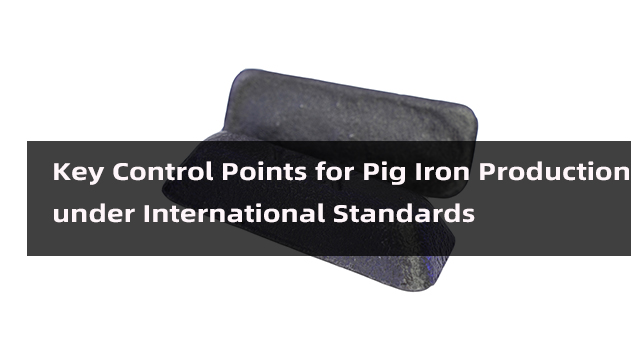pig iron:International Standards
2025-02-05 10:22:47 hits:0
Key Control Points for Pig Iron Production under International Standards

In the current context of a closely - connected global manufacturing industry, pig iron, as an important basic material, must be produced in strict accordance with international standards to ensure product quality and safety. This is not only related to the interests of enterprises themselves but also of great significance for the stable development of the entire industrial chain. The following are the key control points in the production process of pig iron under international standards.
I. Rigorous Screening of Raw Materials
High - quality raw materials are the foundation for producing high - quality pig iron. As the main raw material, iron ore must meet international standards in terms of iron content, gangue composition, and harmful impurity content. For example, the international requirement for the iron element content in iron ore is usually between 55% and 65%. The contents of silicon dioxide, alumina, and other components in the gangue need to be controlled within a certain range to ensure the smooth progress of the smelting process and the quality of pig iron. At the same time, harmful impurities such as sulfur and phosphorus in iron ore are strictly restricted because they can significantly affect the performance of pig iron. Excessive sulfur content will make pig iron have hot brittleness, and excessive phosphorus content will lead to cold brittleness. Generally, in international standards, the sulfur content is controlled below 0.05%, and the phosphorus content is controlled below 0.1%.
In addition to iron ore, coke, as a reducing agent and heat source in the smelting process, also has strict standards. Its fixed carbon content needs to be above 80%, and there are corresponding restrictions on ash content, volatile matter, and sulfur content to ensure stable heat supply and reduction capacity.
II. Precise Control of the Production Process
1. Batching Link
Based on international standards and the composition requirements of the target pig iron, accurately calculate the proportion of raw materials such as iron ore, coke, and fluxes. For example, when producing foundry pig iron, the proportion needs to be adjusted reasonably according to its specific requirements for elements such as silicon and manganese to ensure that the chemical composition of the finished pig iron meets the standards.
2. Blast Furnace Smelting
During the blast furnace smelting process, the control of parameters such as temperature, pressure, and air volume is crucial. In advanced international blast furnace operations, the hearth temperature is stably controlled between 1450 - 1550°C to ensure the full reduction of iron ore and maintain stable furnace pressure to prevent abnormal situations such as hanging charge and slumping charge. By precisely controlling the air volume, ensure that the coke burns fully to provide sufficient heat and reducing gas.
3. Out - of - furnace Treatment
To further reduce the harmful impurities in pig iron and improve its quality, out - of - furnace treatments such as desulfurization and dephosphorization are essential. Advanced out - of - furnace refining technologies are adopted, such as injecting desulfurizing agents and adding dephosphorizing agents. Strictly control the treatment time, dosage, and temperature in accordance with international standards to make the sulfur and phosphorus contents in pig iron meet more stringent standard requirements.
III. Comprehensive Quality Inspection
1. Chemical Composition Detection
During the production process of pig iron, regularly conduct chemical composition analysis of the molten iron. Use advanced equipment such as spectrometers to accurately detect the contents of elements such as iron, carbon, silicon, manganese, phosphorus, and sulfur. Each batch of products needs to be compared with the chemical composition range specified in international standards to ensure full compliance. For example, for pig iron used in nodular cast iron, the silicon content needs to be strictly controlled within a certain range to meet the requirements of subsequent nodularization treatment and casting performance.
2. Physical Property Testing
Carry out physical property tests such as hardness, strength, and toughness on the finished pig iron. Use equipment such as Rockwell hardness testers and universal material testing machines to detect whether the hardness and strength meet the standards. Adopt methods such as impact tests to check its toughness. These physical property indicators are directly related to the performance of pig iron in subsequent processing and use and must meet international standards.
3. Appearance Quality Inspection
Strictly inspect the appearance of pig iron to ensure that there are no cracks, sand holes, gas holes, and other defects on the surface. Based on international standards, formulate detailed appearance defect judgment standards, screen and handle products that do not meet the standards, and ensure the appearance quality of the products leaving the factory.
Controlling pig iron production in accordance with international standards is the key to improving product quality and enhancing enterprise competitiveness. From raw material screening, production process control to quality inspection, every link is closely connected and indispensable. Only by strictly controlling each key point can high - quality pig iron that meets the needs of the international market be produced, contributing to the development of the global manufacturing industry.
Previous: How to make pig iron?

 en
en  fra
fra  de
de  ru
ru  gle
gle  th
th  ara
ara  it
it  jp
jp  kor
kor  zh
zh 


